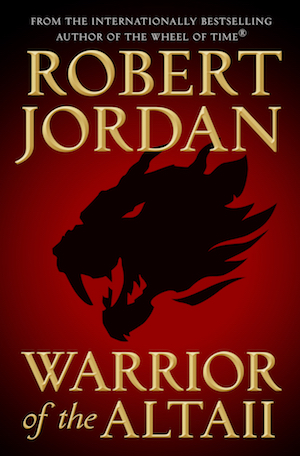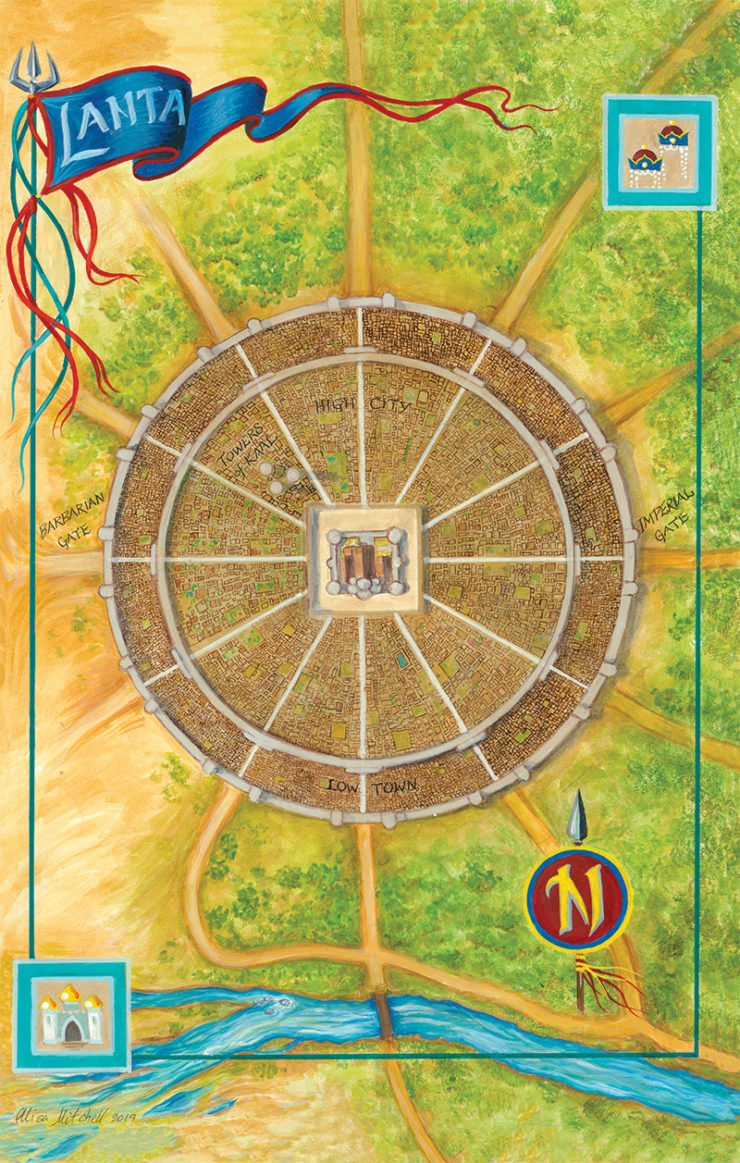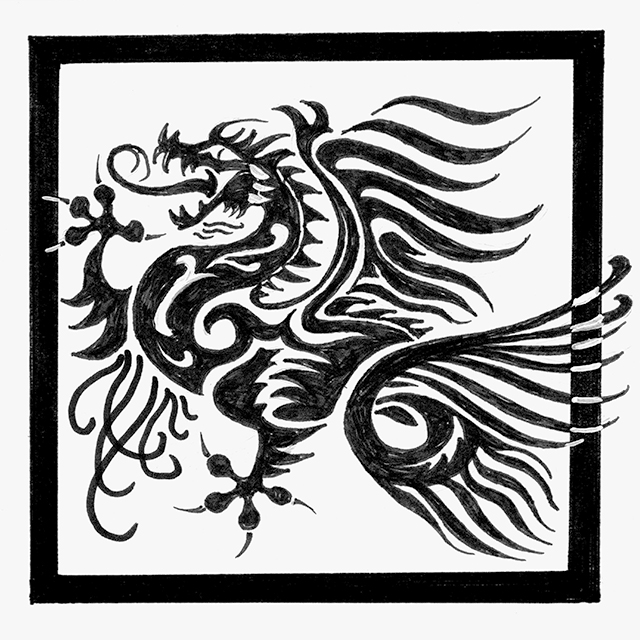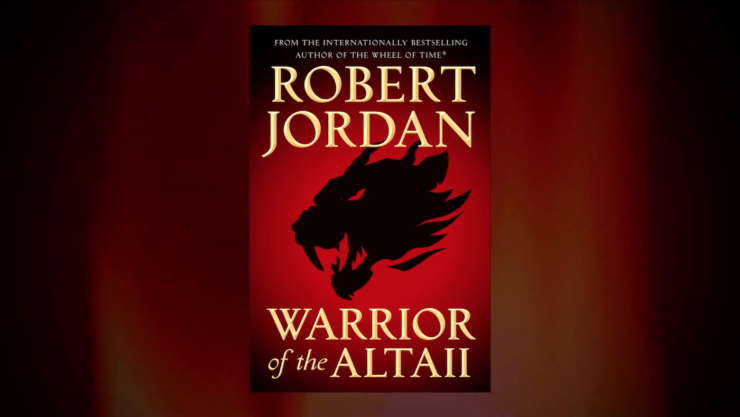Hello, Tor.com! Last week, if you recall, I dazzled you, or at least mildly bounced light off the retinas of you, with my non-spoiler review of Robert Jordan’s newest and yet also oldest novel, Warrior of the Altaii, and also promised I’d be back with a much more spoilery version for your delectation this week.
And as I am a woman of my word, here we are! *throws confetti*
So, obviously, be warned that this post is full of spoilers for Warrior of the Altaii—and, honestly, somewhat spoilery for The Wheel of Time too. If you haven’t read either, proceed with caution… and also go read the Wheel of Time, sheesh.
So There. Onward!
I figure there’s basically two categories of spoilery things that I think you will be interested in hearing about from me re: this book, and they are (a) problematic bits, because everyone always loves hearing about problematic bits, and (b) Wheel of Time bits, because duh. And as those two things actually quite neatly intersect, that works out pretty well, all things considered.
Don’t worry, I will esplain.
Buy the Book


Warrior of the Altaii
So are there problematic bits in WotA, you ask? To which I say, well, young grasshopper, this is a book written in the 1970s in the general style of Conan the Barbarian, so it wasn’t a question of whether it would have problematical areas, so much as it was how problematic they would be. I admit that once I realized what kind of story I was reading, I was cringing, just a bit, in anticipation of how the female characters would be portrayed/treated in the story in particular. You may shocked by this, but scenes of gratuitous rape and pillage are not even remotely my thing.
(You are not shocked by this. No one who has ever met me or read even one post by me is shocked by this. It Is Known.)
Fortunately for me, this was written by Robert Jordan, not Robert E. Howard, and even this early on, it’s clear that Jordan was already far more interested in exploring the idea of women having power than he was in having it stripped from them. So by the lights of the era and the genre he was writing in, WotA could be considered downright progressive, in a way.
This is not to say it’s perfect. There’s an eyeroll-worthy amount of gratuitous nudity involved, for one thing, and we’re apparently supposed to believe that the three-ish women who are enslaved to wait on our protagonist Wulfgar hand and foot are all content with their lot. Uh-huh.
(Oh yes, there’s slavery too, which as everyone knows is my FAVORITE THING EVAR. Ugh.)
And then there’s the treatment of the Elspeth character, which is, frankly, appalling. The existence and treatment of Elspeth as a whole is probably the most bizarre thing in the book, in fact. She starts as such an interesting deviation—she’s an accidental traveler from an alternate dimension! A dimension that’s clearly ours!—but is then instantly reduced to a plot device who gives Wulfgar one vital piece of information and then basically is never heard from again, presumably because she’s too busy being beaten into being a good slave to be the major part of the plot she clearly should have been. Yuck. It was weird and distasteful both morally and narratively, if you ask me.

But to counter that, you also have the existence of Mayra and the Sisters of Wisdom—and yes, that’s exactly the precursor to Aes Sedai/Wise Ones you think it is. If Mayra isn’t a nascent Nynaeve I’ll tug my braid, and she takes exactly zero shit from anyone, including Wulfgar, who by both physical description and demeanor bears more than a slight resemblance to a certain very intimidating and stoic Warder you might know. Their dynamic of mutual respect and cooperation is both the beginnings of Jordan’s exploration of the idea that the power of men and the power of women are separate and yet must balance each other that would become a major theme of the Wheel of Time, and a much-needed palate cleanser for the Elspeth side plot.
And was there rape, you ask? And my answer is… yes? I mean, there is, both implied and on-screen (in a non-graphic way), but honestly the rape scene is… well, technically it was Wulfgar who got raped, but the woman he had sexual congress with (and who was also raped) wasn’t the woman who raped him. Or them. (Look, you have to read the scene to understand this, it involved honest-to-God sex pollen and was just kind of brain-bending all around.)
More confusingly, I’m not sure whether Wulfgar even considered that he had been raped, because I don’t think the author did either. This is a blind spot on Jordan’s part that would go on to generate a whole lot of controversy among the WOT fandom, but it’s hardly an uncommon one. Even today in the #MeToo era, there are a large number of people who believe a man can’t be raped by a woman, so it could be considered unreasonable for me to demand that level of wokeness from a 40-year-old story. But on the upside(?), I guess, the scene therefore left me feeling more bemused than anything else.
At any rate, something about the straightforwardness of how this scene was written (as well as most of the “problematic” scenes in the book—I didn’t even get around to mentioning the lengthy torture sequence) very much captured the time period it was written in, and reading it was very interesting even when it made me cringe a little, because I think it is very different from how nearly anyone, including Jordan himself, would have written the same scenes today.
And like I said, all of this is offset by the perhaps-low-but-nonetheless-important bar WotA easily clears, in that the female characters are not collectively featureless ciphers who only exist to motivate the male characters to do things to them. In fact, other than Wulfgar himself, nearly all of the most important characters in the novel are women.
Including his main antagonists. Twin queens is a new one on me—the closest fictional equivalent I can think of is the four Pevensie siblings in Narnia, which also made no sense—but the strictly female line of succession that led to Queens Eilinn and Elana is definitely a harbinger of Caemlyn’s monarchy in WOT. Though it must be said that the Trakands are about a hundred times cooler than Eilinn and Elana, who subscribe to the Mean Girls school of governance, and definitely deserve every bad thing that eventually happens to them both.
Which brings us around to the other thing we need to discuss: WOT parallels!
Of which there are many, y’all. I’m not even going to try to compile a comprehensive list of them, but here are some of my favorites:
Icons! I missed them more than I realized. Including a certain dragonlike icon that looks very familiar. (Granted, I’m sure the decision to add icons was made after the fact, so in fact this is Tor’s homage to WOT rather than Jordan’s precursor to it, but nevertheless, I much enjoyed having some new ones to look at.)

Jordan also gets to show off his military knowledge with a series of battles that, just like in WOT, you can tell were written by someone with a firm grasp on strategy and tactics. It was highly enjoyable in WOT and is no less so here; in fact the ingenious way Wulfgar uses the Runners to win one particular skirmish is probably the best scene in the book.
On the Plain, water is life. A waterhole is life. The absence of water is death. It is just that simple. The fact breeds respect. The man who poisoned or destroyed a waterhole would be killed immediately. If he did it to keep the water from an enemy it would make no difference. The day would surely come, would, not could, when his own people would need that water. Not even the Morassa would destroy water.
The Altaii are not exactly the Aiel, but they share some definite family resemblances. The idea of a proud desert people is not new to anyone (including reality), but you can see in this rougher less fleshed-out version the beginnings of what would become one of my favorite fictional versions of the trope. Even when I was intensely bothered by the Aiel, I loved them, as I think most WOT fans did. (And the Aiel are pillars of moral rectitude compared to the Altaii, for which I am very grateful.)
His tunic was of many colors, slashed after the fashion of Lanta so that other colors showed when he bowed to us.
Only true WOT nerds instantly know why I cracked up laughing at the description of this guy’s clothes. Oh, RJ, we miss you, crazy slashed clothes obsession and all.
And then there’s this:
“You’ve become a link, Wulfgar, a connector between this world and powers beyond. I’m not saying you have any powers of your own,” she added quickly. “You’re not the first male to become a Sister of Wisdom, or would it be brother, but I’ve never heard of a male being such a link before. You’re going to be the focus of events, and not always events of your choosing or liking. You’ll be a catalyst, setting off things by your mere presence, even if you do nothing.”
Yep. I’m pretty sure we all know where that’s going, even if this novel only barely introduced the ta’veren concept, or the idea of a man wielding powers normally restricted for women. It left it open for more to happen in the future, but WotA only scraped the surface of what Wulfgar’s “focus” status meant for him and his world. It would have been far more tantalizing a glimpse if I didn’t already know it gets so much fuller (and better) treatment in WOT years later.
And really, this can be said of all the parallels I’ve noted, and the story itself. This is what I meant when I said in the non-spoiler review that it made more sense to have published Warrior of the Altaii now, after The Wheel of Time has been finished, than before. The book stands on its own, but I think ultimately it is more interesting to read as the simpler springboard from which deeper and much more complex things were to come; the primer paint to WOT’s glossy finish, if you will.
Not the beginning, but a beginning, perhaps.
And that’s what I got, kids! If you’ve read Warrior of the Altaii, please share your thoughts! Did you agree, do you disagree, did I miss something? I probably did, so come and tell me all about it. Cheers!
Warrior of the Altaii is available from Tor Books.
Leigh Butler is a writer, blogger and critic, who feels that humor, weirding of language, and the occasional application of head to desk is the best way to examine the impact of sociocultural issues on popular SF works (and vice versa). She has been a regular columnist for Tor.com since 2009, with multiple series to her name: The Wheel of Time Reread, A Read of Ice and Fire, the Movie Rewatch of Great Nostalgia, and now the Reread of the Ruin of Kings by Jenn Lyons. Leigh lives in New Orleans, and therefore advises alla y’all to let your good times roll.










